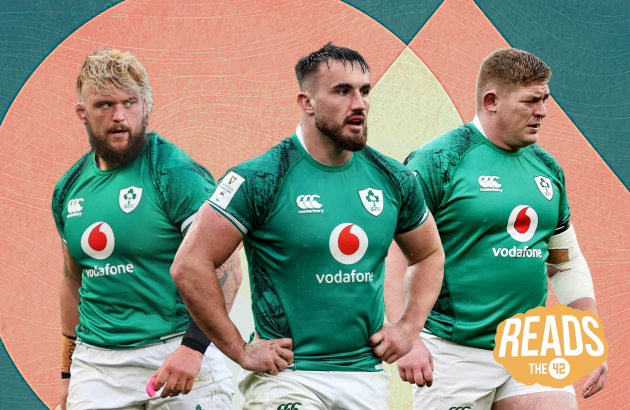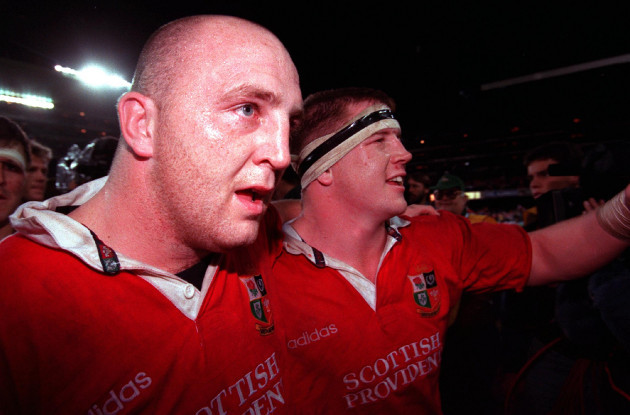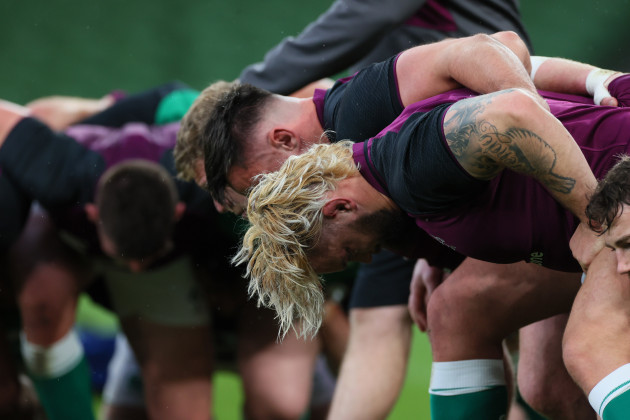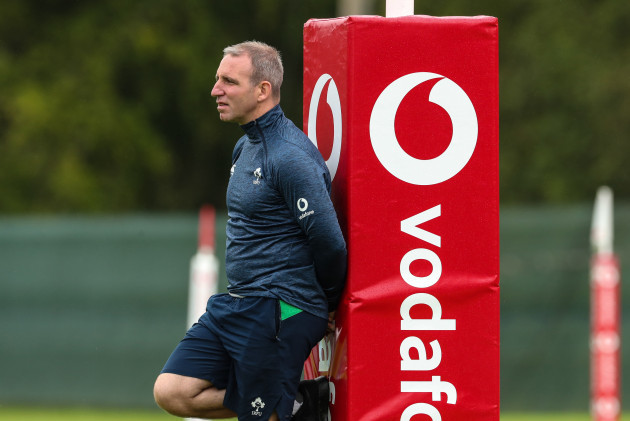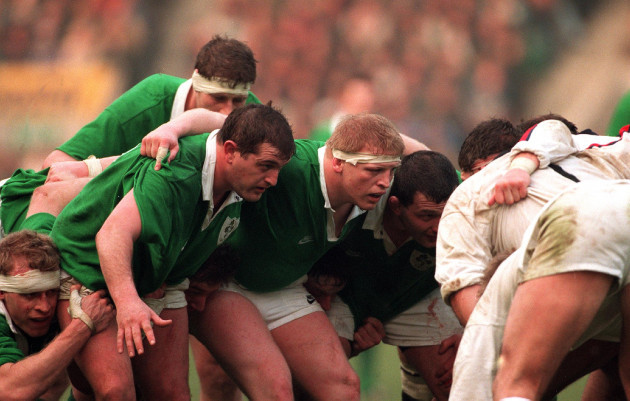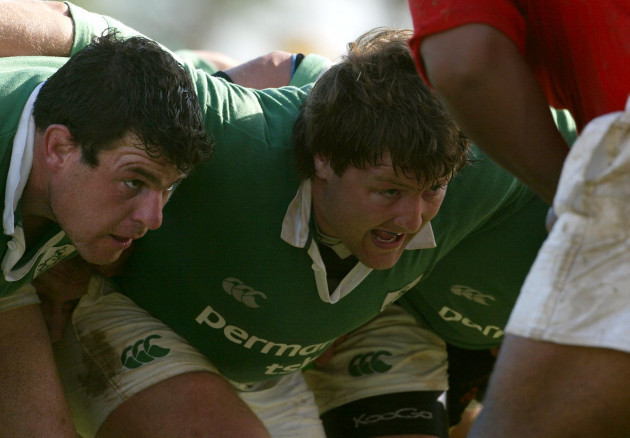IT WAS ON a tour to New Zealand 30 years ago. Ireland were playing the All Blacks, the scoreboard racing towards the 50-points mark.
The first test may have been a dream but this? Well, this was grim. As New Zealand piled on score after score, Nick Popplewell could hear the sneers from the Wellington crowd and see the mocking words forming in the mouths of their fans.
That was when the membership of the Irish front row, Popplewell, Stevie Smith and Paul McCarthy, briefly gathered for a party conference. First item on the agenda: Sean Fitzpatrick.
The All Blacks hooker, captain and chief tormentor had pissed them all off.
“What’s the plan?” Popplewell asked.
“We’ll drop the next scrum,” Smith and McCarthy suggested.
Down it went.
“And that was when Stevie thumped Fitzpatrick.”
Inevitably a melee followed and by the end of it, Fitzpatrick was on the ground, rooting around the grass. It was a strange time to take up gardening.
When he looked up to tell Smith and Popplewell he had lost ‘his f**king teeth,’ he received some surprising dental advice. “You won’t find them down there,” Smith said before raising his hand for the big reveal. “Two of Fitzpatrick’s teeth,” Popplewell tells us, “were stuck in that fist of his.”
- See sport differently with The42 Membership and get closer to the stories that matter with exclusive analysis, insight and debate. Click here to find out more>
That was how it was in the dying years of the amateur era. Nobody but nobody went near the front row without a health warning – a place where props and hookers all looked the same: moustached and mean.
If someone said they didn’t want to meet an opposing prop down a dark alley, well that was the ultimate compliment. As for handling skills, mobility, footwork, well those words were peppered into other players’ conversations. No one ever asked if a front-rower could fit those qualities into their job spec because no one cared.
THE GAME-CHANGERS
When you watch old videos of Keith Wood, it’s hard not to feel a sense of history changing. Wood grew up in Clare with nothing but a dream and managed to become the best hooker in the world. He broke the mould, sidestepping backrowers and centres, balancing the old-school requirements of a hooker with a new box of tricks. He could pass, carry, jackal and tackle with the best of them.
The trouble was he didn’t play with the best of them. Ireland in the ‘90s were bloody awful, perennial losers in the old Five Nations and in everything else. It was only when Wood got on the Lions tours in 1997 and 2001 that he was able to show the world what he could do.
It didn’t go unnoticed closer to home. His successor with Ireland and the Lions, Shane Byrne, was a superb player, quick, tough and vastly underrated. Across the scrum, Popplewell – Ireland’s only Test starter on the ’93 Lions tour – had a world class label deservedly stuck around his neck. Then you had The Claw. Even family members called Peter Clohessy, Claw. He was a hard man; but also an undervalued ball-player.
Bull Hayes came later and Ireland became so reliant on him in the noughties that prayers were offered up every time he went down with an injury. A decent tighthead, he was an exceptional lifter in the lineout, a human forklift for Paul O’Connell. Maul time was Bull’s time. Once, after a game in Murrayfield in 2005, he was credited with a try after Ireland rumbled the Scots over the line. “That your first time scoring for Ireland?” a journalist texted him after the game.
“Yeah,” he messaged back. “And it wasn’t even my try; Keith Gleeson got it.”
The position was evolving; the ability to scrummage remained constant but coaches started adding other chores to their daily list. One of those was the ability to be invisible in the defensive line, so that faster, more nimble opposition backs didn’t notice you. Hayes was good at that but even he got found out, Vincent Clerc stepping inside him in the dying minutes of the 2007 Six Nations encounter. That try cost Ireland a grand slam.
Now all these years later, three hombres with a bit of Bull, a bit of Claw and a bit of Wood have emerged. There’s Ronan Kelleher, 24, born six months after Wood’s iconic performances for the Lions in South Africa – a fast, elusive, tough hooker who has an eye for the line, scoring six tries in 16 internationals. “He is a hard man alright,” says Byrne. “Think of the weight per square inch bearing down on you when you are in the middle of a front row. Now look again at Ireland’s recent scrums and check out the shoulder movements (of Kelleher).
“You always notice Kelleher’s shoulders shifting (in the scrum). That’s a sign of a hard worker; he’s class.”
He isn’t alone. Andrew Porter is next to him. Porter started his career as a loosehead, moved to tighthead, and is now back at loosehead. That’s a little like Freddie Mercury reinventing himself as Brian May at the start of his career and then becoming a frontman again midway through it.
Porter can scrummage effectively, although former front-row tradesmen, Popplewell and Des Fitzgerald, are slightly critical of his performance last weekend. “For me, his feet were too far back (in the scrums),” reckons Fitzgerald, who won 34 caps as a prop for Ireland and played in two World Cups. “He was not using the power in his legs to assist his upper body; therefore he was bent a little. If he brings up his legs he will generate more power.”
Still, he likes what he sees, not just in Porter but also in Kelleher and ‘the best tighthead in the world’ – Tadhg Furlong. “They’re phenomenal rugby players,” Fitzgerald says. “Scrummaging is important in the modern game, but it’s only important if you are bad at it.
“Those boys, they’re more than competent as scrummagers. That means the other things they do, tackling, carrying, mauling, become more important. The three of them, they’re unbelievably good at everything. Everything.”
The evidence has been there for a while. Click Furlong’s name into YouTube and you’ll see videos of him sidestepping a trio of venerable All Blacks in 2016; offloading in the tackle to set up CJ Stander for a try in the grand slam winning game in 2018, popping passes as a first receiver, bulldozing his way across the gainline.
“He has magnificent balance when he runs,” says Fitzgerald, “and the importance of that is seen whenever he is running at a defender whose feet are in the wrong position. When you have his strength, coupled with his balance, and you attack a guy at speed, your hand-off is almost like hitting a guy with a crutch. Furlong’s ability to transfer his weight is just incredible.”
“The best in the world,” agrees Popplewell. “In fact I’ll go further. We’ve the best front row in international rugby. Name me a better one.”
“France’s?” asks Romain Magellan, a former France A and Saracens prop, now the voice of rugby on Canal Plus.
“Mmmm,” says Popplewell, pausing for a second. “I don’t think so. Our boys are the best. Put it this way, we’re about to find out.”
**
LE CRUNCH
If you are wondering why these things matter then consider the following figures. Five of the 20 most watched programmes on Irish television last year were rugby matches. In 2018, it was six out of 20, with the wins over England and New Zealand ranked second and third on the listings behind The Late, Late Toy Show.
Never has the game reached as wide an audience here, 841,000 people tuning in at 4.07pm for last Saturday’s game, an additional 96,000 people downloading a stream on the RTÉ Player. Oh, and there were 51,000 fans inside the stadium. All in, that’s a fifth of the population.
So we’re not exactly giving away state secrets when we say sport has relevance in people’s lives. They want the team to do well and if that’s going to happen then they’ll need a functioning scrum. “Yes, but never before did we associate Ireland with the set-piece,” says Canal Plus’s Magellan. “Your back-row, yes, was always very good. Your front row, now it is a great one. Before, we maybe would have viewed it as a weakness.”
It’s a funny choice of word: weakness. Porter, Kelleher and Furlong’s predecessors would all have been big men, 18-stone fellas.
But they were never considered a dominant trio the way these chaps are. Right now they are on the cusp of real stardom because in so many ways the traits we associate with Furlong, Kelleher and Porter are traits commonly ascribed to the perfect Irish sporting hero. They make humility and brilliance rhyme.
Furlong ‘the best in the world’ had to do a stint as a replacement last year after coming back from injury. Porter, too, had to serve a long apprenticeship as Furlong’s understudy before his latest positional switch; Kelleher similarly served as back-up to Rob Herring. None of them complained.
By now, after years of evolution in the job spec, they’re known for what they do around the park more than they are for their effectiveness in the set-piece. Last year, Furlong stepped inside two Scottish defenders like a latter-day Phil Bennett. Last week he popped a no-look pass to Sexton after giving the impression he was going to charge at a couple of Welsh defenders. He also lifts, mauls, carries, tackles and cleans out rucks. The only thing the man doesn’t do is present the Six One News.
“Tadhg Furlong is an academic tighthead,” says Byrne. “He is not just a big beef; he has a repertoire of tricks. You can see if he is under pressure in one scrum that the next won’t be the same. You can see him physically working his way into the position he wants to get to; once you see that, you know his opponent is in trouble.”
— Murray Kinsella (@Murray_Kinsella) March 15, 2021
Porter is equally impressive. Until September he and Furlong were rivals for the one position. Now they are colleagues across the scrum, reliant on one another. Add in Kelleher’s rapid maturity, his progression from bench to starter and you have a world class combo.
“No scrum, no win, that is the cliché in French rugby,” says Magellan. “Scrum is our speciality. You Irish, you play f***ing well at the moment and while I don’t know if the average person on a Parisian street knows the name of Ireland’s props, me, I know them. They are very, very good.
“That’s why we, in France, don’t just view Ireland as a team with a fighting spirit, a team with a good back row and some nice back moves. There is much more to them than that. They are dangerous.”
THE CHARACTERS
Enda McNulty recalls watching the boys scrummage. They moved so intently, eyes fixed on their opposite number. Greg Feek, Ireland’s then scrum coach, studied their movements, the sinew of their muscle, the subtle shifts in their stance. Situated in a corner of Carton House – ‘so far removed from the entrance that only someone with binoculars would have been able to see what was going on’ McNulty felt like a guy with a ringside seat at a world heavyweight boxing fight.
“For the rest of my life I will never forget that session,” says McNulty, the former Ireland team psychologist who worked closely with Furlong and Porter. “It reminded me of being a child watching thoroughbred pedigree cattle fighting in the pen, the aggression, the unbelievable sense of fight and battle that these guys possessed. Those scrum sessions lasted for 12 to 15 minutes. They were incredibly intense.”
Each time Ireland do a scrum session, there are three video cameras there to record it – one from an aerial slot, one from the right, one from the left. Later, they’ll all revisit those moments, Furlong, Kelleher and Porter, with Feek’s successor, current scrum coach, John Fogarty. Errors are quietly addressed, opportunities mapped out.
“If you are asking me to reflect on why these guys are so good, it is because they have been doing thousands of hours of practice across their careers, getting that quality of preparation,” says McNulty. “They have learned from greats who have been before, like Rory Best or greats who are still around, like Cian Healy. When you are surrounded by that environment and you add to that their character, their in-built resilience, you get what you see now. Quality of coaching shapes their tactical awareness; quality of environment shapes their standards.”
That’s not all. All three have overcome hardship in their lives. Furlong, from a Wexford farming background, has admitted it took him time to adjust to city life when he first moved to Dublin, purposely living with non-athletes to get some distance from the rugby bubble.
Noel McNamara worked with Kelleher and Porter in both the Ireland Under 20 and the underage Leinster set-ups, noticing a fierce competitiveness in each player. “At everything,” he says, “for every second of every training session. They were relentless. Gym, pitch, they wanted to know what their targets were.
“These were the boys sitting at the front of team meetings with their notebooks out, scribbling down things they needed to learn. They didn’t just train to go through the motions. For Ports, every scrum, carry, lift, his mindset shone through. Ronan was the same; I watched Tadhg train and he was also cut from that cloth. They were so demanding of themselves.”
Life has proved even more demanding, injuries hindering Kelleher and Porter’s development as teenagers – but by then Porter had something even more traumatic to endure, the tragic loss of his mother, Wendy, to cancer. He has spoken openly about how he dealt with that grief, his mother forever in his thoughts.
“They’re remarkable people,” says McNamara of Porter and Kelleher. “Unfazed, that’s how I’d describe them. Nothing panics them. You see it with Andrew, like how he got injured before the British and Irish Lions tour and then how he responded. He changed position and instantly established himself as a world class loosehead.
“Talent is obvious but once you reach a certain amount in your career, your character becomes more important. People underestimate a player’s spirit (as a reason why they make it to the top). They shouldn’t. It matters. It is visible in Andrew, Ronan and Tadhg now and because they are still so young, it could be visible for another 10 years.”
Character is needed at the highest level because every quality you possess, your opponent has too. Every mistake is magnified. Every game, in a sport as brutal as this, has the potential to be your last. That’s something for a player to think about. Don’t pretend they don’t.
“I’ve watched 15 years of scrum sessions with Leinster and Ireland,” says McNulty. “And at no stage did I ever feel comfortable. I’ve almost bitten my tongue observing the intensity of those battles. They’re brave men.”
Popplewell knows it, Fitzgerald and Byrne too. It was kind of surreal listening to all three former players talk about Kelleher, Porter and Furlong. It was almost as though they knew them on a personal basis. They don’t. What they do know, though, is something the rest of us have no idea about – the suffering that goes on after a referee says crouch, bind, set.
“There were times in there when you were in serious trouble,” says Popplewell, “when you really felt under pressure. Now I am not saying you felt like you were going to break your neck or anything but you knew you were reliant on the fellas next to you.”
He tells a funny story about The Claw. They had an understanding. When under the cosh, they had a call. Scaoil, the Irish word for drop it. Once all three went down simultaneously, the referee couldn’t pin the blame on an individual. One year, against Australia, Claw was frantically screaming As Gaeilge. The scrum eventually broke up.
“Claw came over to myself and Terry Kingston and said ‘lads did you not hear my f**king call?’
“Yes,” replied Popplewell, “but why the f**k were you asking for siúcra (sugar)?”
THE DARK ARTS
Shane Byrne will never forget the pain. Now and then he’d scrummage against bigger men. Steve Thompson was one. That was when Byrne angled his shoulder to scrummage like a loosehead, hoping to upset Thompson that way.
That’s fine in theory. But there were times when he didn’t get into the right position and Thompson’s body weight bore down on Byrne’s neck. We can only imagine the pressure, each second feeling like a minute. “As a hooker, as a tighthead, sometimes you just have to grin and bear it, grit it out,” says Byrne. “Many a time you are in a scrum at that level and you know it is going to hurt. But you also know you can’t go back. If a tighthead gets it wrong and a loosehead has slipped underneath his shoulder and starts to drive up through your chest, it is horrible. If a tighthead is strong enough to still hold his opponent then you just have to take it.”
That’s why he admires Furlong so much, but also Kelleher and Porter. “They’re excellent,” says Byrne. “Ireland’s scrum is rarely under pressure. Tadhg Furlong is what I’d call a learning tighthead.
“What I mean by that is that I have seen him come up against some very, very powerful men and he always ends up coming out on top. It might take a few scrums, one or two may go awry. A good tighthead will take out his little black book and try something else in the next scrum. That’s Tadhg. I have never seen him end up getting done, certainly not in recent times.”
Nor has Kelleher ever come unstuck. Byrne admires the latest occupant of the No2 shirt’s ability to dictate the height he wants to scrummage at, his flexibility to adjust to a bigger opponent, his ability to dominate smaller but technically smart rivals.
“The hooker’s technique is the hardest one to judge because 90 per cent of him is covered,” says Byrne. “There are always tell-tale signs, though, the effort that goes in with the shoulders, how he forces himself to get into the position he wants to be in to strike the ball. So, he is working his way through the scrum and to do that, you have to have a lot of strength. He knows what he is doing.”
Then there is Porter. “He is a different machine altogether. To go from a loosehead to a tighthead is the hardest thing to do in rugby; so for him to survive at international level makes him a superb scrummager.”
That is before we mention everything else he does on the park. Against New Zealand last November, Porter was scrambling across his defensive line in the 74th minute to help Keith Earls make a decisive tackle. Think about that level of fitness. Seventy-four minutes and still able to sprint at full pelt. “In the old days, you were trying to hide your front row guys in defence,” says McNamara. “Now their speed makes them an asset. And that’s before we mention what they offer in attack. Andrew, Ronan and Tadhg have made our attack better with their carries, their tip on passes, their ability to mix things up, their tries.”
The long-term implication is obvious. At 29, 26 and 24, they have a future together, a future where Ireland has an explosive scrum, a trio of fine maulers and exceptional ball-playing forwards. With a good front row, every team has a chance.
Ireland’s, however, is better than good, it’s immense.
“I don’t know these boys but I am proud of them,” says Fitzgerald. “The set of forwards we currently have, they are so comfortable on the ball. It’s a pleasure to watch them.”
As he said those very words, Ireland landed in Paris. Once they travelled here with all the confidence of men about to face the firing squad. Now it’s different. Porter, Kelleher and Furlong are a newish combination, so much so that some in the rugby world aren’t fully aware of how good they are.
They are about to find out.
See sport differently with The42 Membership and get closer to the stories that matter with exclusive analysis, insight and debate. Click here to find out more>
